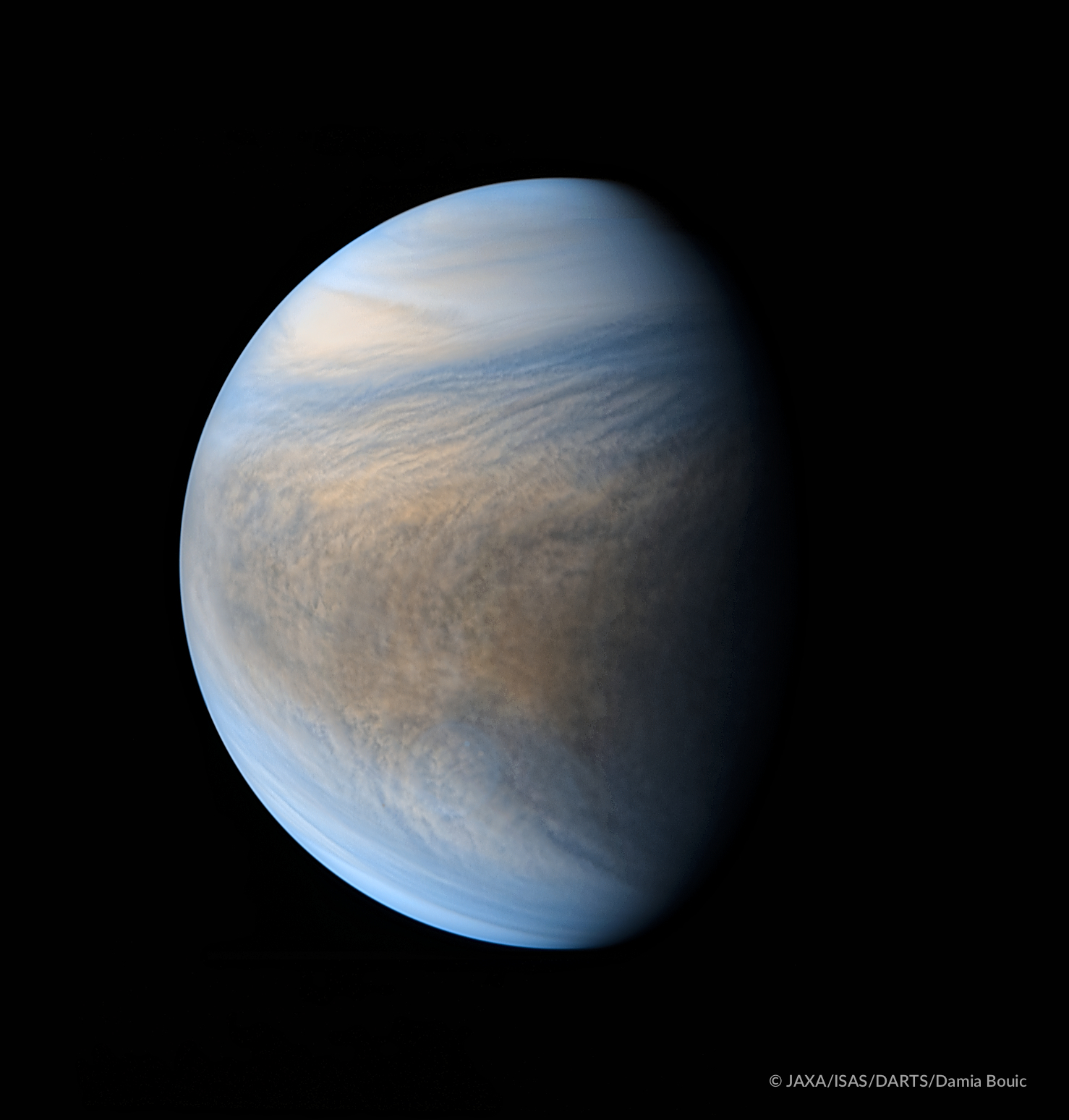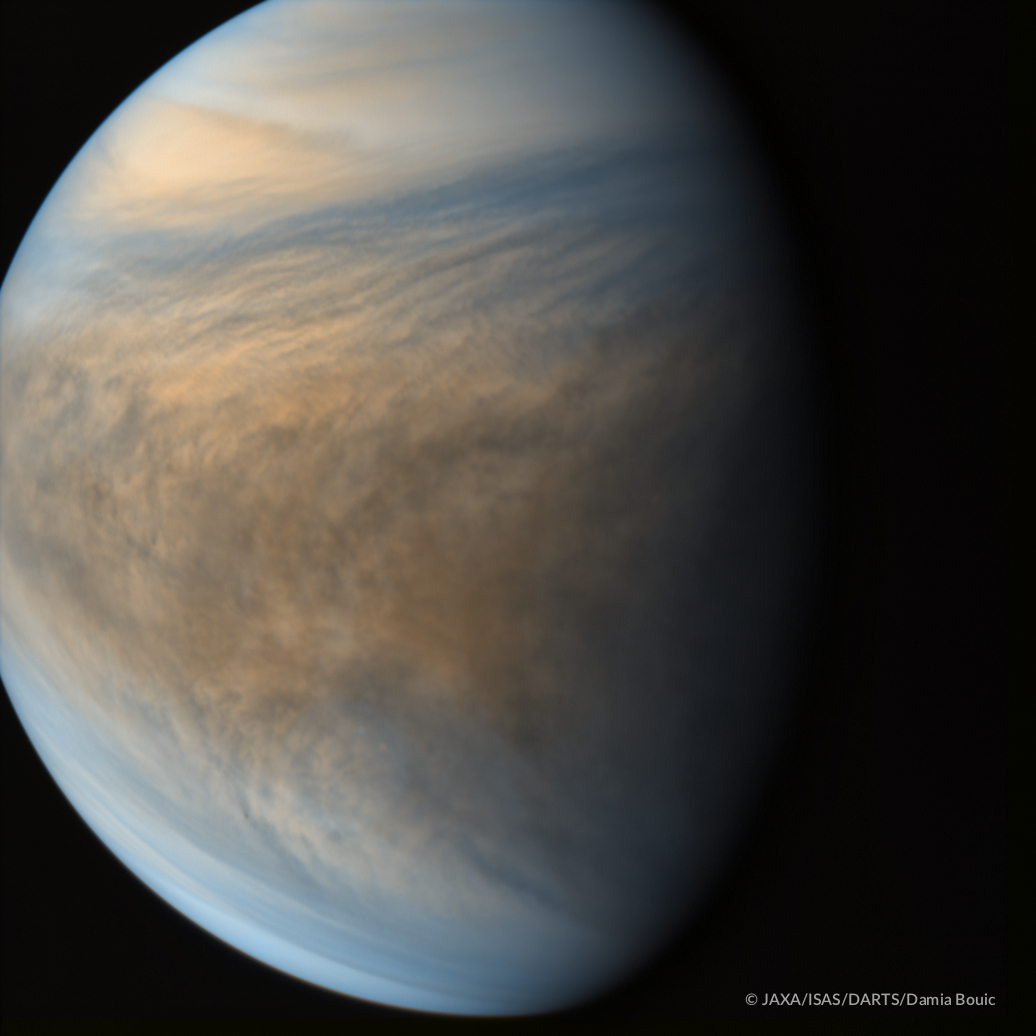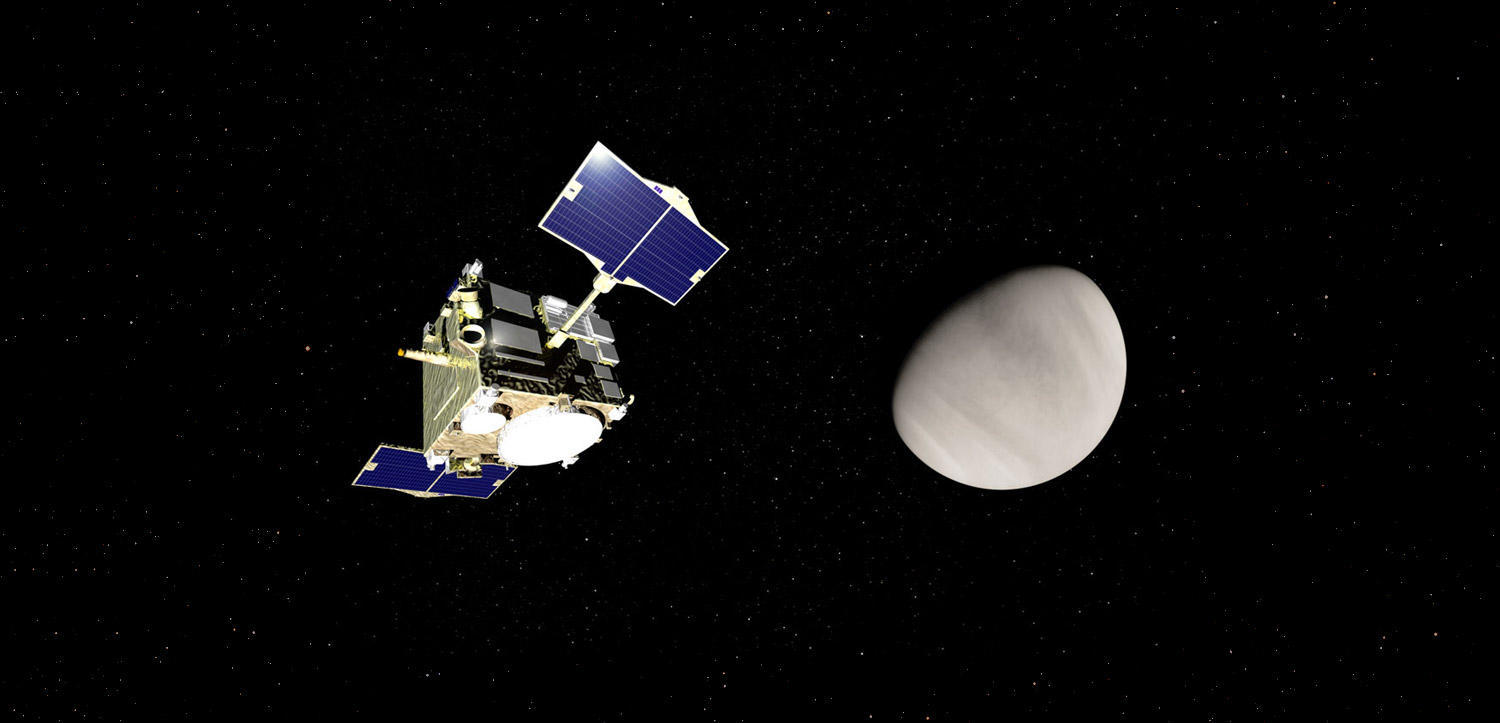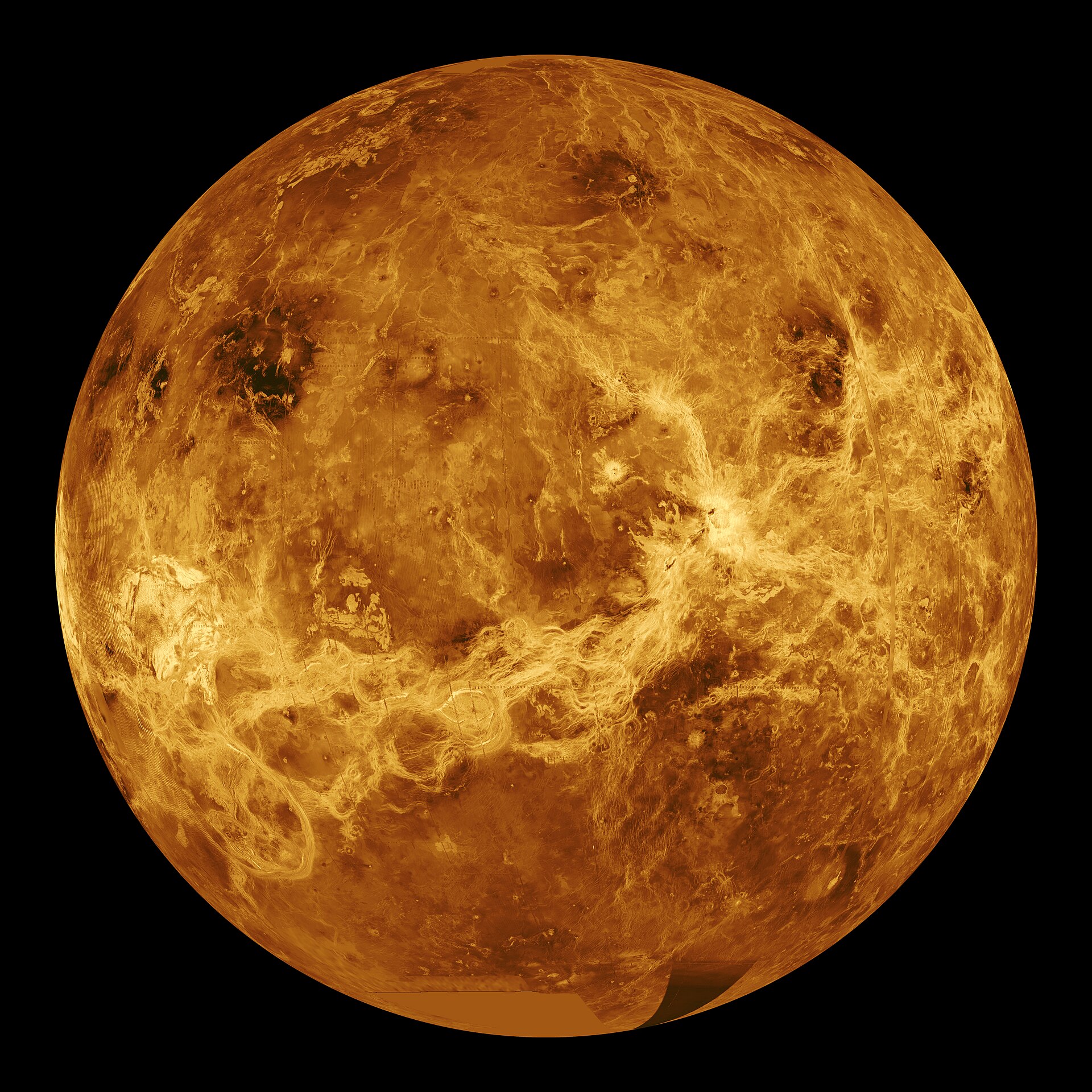- My Forums
- Tiger Rant
- LSU Recruiting
- SEC Rant
- Saints Talk
- Pelicans Talk
- More Sports Board
- Fantasy Sports
- Golf Board
- Soccer Board
- O-T Lounge
- Tech Board
- Home/Garden Board
- Outdoor Board
- Health/Fitness Board
- Movie/TV Board
- Book Board
- Music Board
- Political Talk
- Money Talk
- Fark Board
- Gaming Board
- Travel Board
- Food/Drink Board
- Ticket Exchange
- TD Help Board
Customize My Forums- View All Forums
- Show Left Links
- Topic Sort Options
- Trending Topics
- Recent Topics
- Active Topics
Started By
Message
Japanese probe Akatsuki's pictures of Venus
Posted on 2/1/18 at 8:16 pm
Posted on 2/1/18 at 8:16 pm
This is pictures made from someone looking through the crafts image files and processing them.
LINK
Akatsuki (also known as PLANET-C and Venus Climate Orbiter) is a Japanese mission that launched almost eight years ago, in 2010. It missed its first attempt to orbit Venus on December 7, 2010 due to the failure of its orbital insertion rocket. It was only on December 7, 2015, after several years of wandering around the Sun, that Akatsuki succeeded in placing itself in orbit around the enigmatic planet. Even though the new orbit of Akatsuki is distant and highly elongated, a large portion of the original science objectives may still be achieved.
That's Akatsuki's story. I was not very interested in this mission until one day when curiosity took me to its website, where I found the archival images from the mission. I thought it might be nice to try to process some images, just to see what happened. I am not disappointed with the result, which I present to you below.

Composite view consisting of two images taken at two different distances, allowing amateur image processor Damia Bouic to fill some gaps to create this detailed view of Venus. Taken using the UV1 filter, many details are revealed, especially in terms of convective activity in the venusian atmosphere.

A false-color image using two ultraviolet channels from Akatsuki's UVI camera. Venus' cloud dynamics are just as complex as Earth's.
Akatsuki Wiki
Akatsuki (????, ?, "Dawn"), also known as the Venus Climate Orbiter (VCO) and Planet-C, is a Japanese (JAXA) space probe tasked to study the atmosphere of Venus. It was launched aboard an H-IIA 202 rocket on 20 May 2010,[6] and failed to enter orbit around Venus on 6 December 2010. After the craft orbited the Sun for five years, engineers placed it into an alternative elliptical Venusian orbit on 7 December 2015 by firing its attitude control thrusters for 20 minutes.[4][5][7][8]

LINK
Akatsuki (also known as PLANET-C and Venus Climate Orbiter) is a Japanese mission that launched almost eight years ago, in 2010. It missed its first attempt to orbit Venus on December 7, 2010 due to the failure of its orbital insertion rocket. It was only on December 7, 2015, after several years of wandering around the Sun, that Akatsuki succeeded in placing itself in orbit around the enigmatic planet. Even though the new orbit of Akatsuki is distant and highly elongated, a large portion of the original science objectives may still be achieved.
That's Akatsuki's story. I was not very interested in this mission until one day when curiosity took me to its website, where I found the archival images from the mission. I thought it might be nice to try to process some images, just to see what happened. I am not disappointed with the result, which I present to you below.

Composite view consisting of two images taken at two different distances, allowing amateur image processor Damia Bouic to fill some gaps to create this detailed view of Venus. Taken using the UV1 filter, many details are revealed, especially in terms of convective activity in the venusian atmosphere.

A false-color image using two ultraviolet channels from Akatsuki's UVI camera. Venus' cloud dynamics are just as complex as Earth's.
Akatsuki Wiki
Akatsuki (????, ?, "Dawn"), also known as the Venus Climate Orbiter (VCO) and Planet-C, is a Japanese (JAXA) space probe tasked to study the atmosphere of Venus. It was launched aboard an H-IIA 202 rocket on 20 May 2010,[6] and failed to enter orbit around Venus on 6 December 2010. After the craft orbited the Sun for five years, engineers placed it into an alternative elliptical Venusian orbit on 7 December 2015 by firing its attitude control thrusters for 20 minutes.[4][5][7][8]

This post was edited on 2/1/18 at 8:18 pm
Posted on 2/1/18 at 8:18 pm to DavidTheGnome
I was hoping to see some pyramids
Posted on 2/1/18 at 8:24 pm to Brosef Stalin
The probe first failed in orbiting Venus due to a faulty engine but eventually did reach orbit. This is one of its first images back:

Article about it reaching Venus and it’s first images

Article about it reaching Venus and it’s first images
Posted on 2/1/18 at 8:26 pm to DavidTheGnome
All edited, composite images. So, just like Earth, we have no real pictures showing us what the planet looks like.
Posted on 2/1/18 at 8:26 pm to DavidTheGnome
The darker brown spot is shaped just like North America.

Posted on 2/1/18 at 8:27 pm to DavidTheGnome
Wait I don’t see this on tFront Page
Posted on 2/1/18 at 8:27 pm to DavidTheGnome
LINK
It also may have detected a gravity wave
A monster wave roils in the atmosphere of Venus. The Akatsuki orbiter team, under the Japanese Aerospace Exploration Agency (JAXA), recently revealed images of the huge bow-shaped wave in the upper atmosphere of Venus.
The finding comes from data Akatsuki gathered in late December 2015 and early January 2016, shortly after orbital insertion. The team released the results on January 16th in Nature Geoscience. The spacecraft's Longwave Infrared Camera (LIR) and the Ultraviolet Imager (UVI) captured the images of the Venusian atm

The bow-shaped feature spans the Venusian cloudtops from hemisphere to hemisphere, more than 6,200 miles (10,000 km) long. Although the cloud tops whip along at 100 meters per second (200 mph) — much faster than the slow-moving surface of the planet below — the curious structure seems to stay in lockstep with the rotation of the planet, suggesting a complex (and previously unsuspected) interplay between the mountainous surface and the sulfurous cloudtops. The structure appeared near the evening terminator on the daytime side of Venus.

It also may have detected a gravity wave
A monster wave roils in the atmosphere of Venus. The Akatsuki orbiter team, under the Japanese Aerospace Exploration Agency (JAXA), recently revealed images of the huge bow-shaped wave in the upper atmosphere of Venus.
The finding comes from data Akatsuki gathered in late December 2015 and early January 2016, shortly after orbital insertion. The team released the results on January 16th in Nature Geoscience. The spacecraft's Longwave Infrared Camera (LIR) and the Ultraviolet Imager (UVI) captured the images of the Venusian atm

The bow-shaped feature spans the Venusian cloudtops from hemisphere to hemisphere, more than 6,200 miles (10,000 km) long. Although the cloud tops whip along at 100 meters per second (200 mph) — much faster than the slow-moving surface of the planet below — the curious structure seems to stay in lockstep with the rotation of the planet, suggesting a complex (and previously unsuspected) interplay between the mountainous surface and the sulfurous cloudtops. The structure appeared near the evening terminator on the daytime side of Venus.

Posted on 2/1/18 at 8:28 pm to DavidTheGnome
Venus is probably the most inhospitable planet in the system.
Posted on 2/1/18 at 8:28 pm to DavidTheGnome
So that’s where women come from.
Posted on 2/1/18 at 8:28 pm to DavidTheGnome
Looks like Venus has a 70's bush.
Posted on 2/1/18 at 8:29 pm to DavidTheGnome
I see 2 faces in the middle of the first pic, one on the left is human and the one on the right is 
Posted on 2/1/18 at 8:30 pm to weagle99
quote:
Venus is probably the most inhospitable planet in the system.
Of the rocky planets, yes. The gas giants are just gas so they are inhospitable as well, but their moons offer opportunities.
Posted on 2/1/18 at 8:30 pm to TigerFanatic99
quote:
All edited, composite images. So, just like Earth, we have no real pictures showing us what the planet looks like.
Venus is flat, isn't it.
Posted on 2/1/18 at 8:38 pm to DavidTheGnome
Nudes on Reddit
This post was edited on 2/1/18 at 8:39 pm
Posted on 2/1/18 at 8:40 pm to DavidTheGnome
Jesus... That green mass in the second picture looks like the United States.
Posted on 2/1/18 at 9:01 pm to Jobu93
Venus
Venus is the second planet from the Sun, orbiting it every 224.7 Earth days.[12] It has the longest rotation period (243 days) of any planet in the Solar System and rotates in the opposite direction to most other planets. It has no natural satellites. It is named after the Roman goddess of love and beauty. It is the second-brightest natural object in the night sky after the Moon, reaching an apparent magnitude of -4.6 – bright enough to cast shadows at night and, rarely, visible to the naked eye in broad daylight.[13][14] Orbiting within Earth's orbit, Venus is an inferior planet and never appears to venture far from the Sun; its maximum angular distance from the Sun (elongation) is 47.8
Size comparison with Earth:

Venus is one of the four terrestrial planets in the Solar System, meaning that it is a rocky body like Earth. It is similar to Earth in size and mass, and is often described as Earth's "sister" or "twin".[20] The diameter of Venus is 12,103.6 km (7,520.8 mi)—only 638.4 km (396.7 mi) less than Earth's—and its mass is 81.5% of Earth's. Conditions on the Venusian surface differ radically from those on Earth because its dense atmosphere is 96.5% carbon dioxide, with most of the remaining 3.5% being nitrogen.[21]
Global radar view of Venus (without the clouds) from Magellan between 1990 and 1994:

Venus is the second planet from the Sun, orbiting it every 224.7 Earth days.[12] It has the longest rotation period (243 days) of any planet in the Solar System and rotates in the opposite direction to most other planets. It has no natural satellites. It is named after the Roman goddess of love and beauty. It is the second-brightest natural object in the night sky after the Moon, reaching an apparent magnitude of -4.6 – bright enough to cast shadows at night and, rarely, visible to the naked eye in broad daylight.[13][14] Orbiting within Earth's orbit, Venus is an inferior planet and never appears to venture far from the Sun; its maximum angular distance from the Sun (elongation) is 47.8
Size comparison with Earth:

Venus is one of the four terrestrial planets in the Solar System, meaning that it is a rocky body like Earth. It is similar to Earth in size and mass, and is often described as Earth's "sister" or "twin".[20] The diameter of Venus is 12,103.6 km (7,520.8 mi)—only 638.4 km (396.7 mi) less than Earth's—and its mass is 81.5% of Earth's. Conditions on the Venusian surface differ radically from those on Earth because its dense atmosphere is 96.5% carbon dioxide, with most of the remaining 3.5% being nitrogen.[21]
Global radar view of Venus (without the clouds) from Magellan between 1990 and 1994:

Posted on 2/1/18 at 9:12 pm to DavidTheGnome
LINK
NASA Climate Modeling Suggests Venus May Have Been Habitable
Venus may have had a shallow liquid-water ocean and habitable surface temperatures for up to 2 billion years of its early history, according to computer modeling of the planet’s ancient climate by scientists at NASA’s Goddard Institute for Space Studies (GISS) in New York.
NASA Climate Modeling Suggests Venus May Have Been Habitable
Venus may have had a shallow liquid-water ocean and habitable surface temperatures for up to 2 billion years of its early history, according to computer modeling of the planet’s ancient climate by scientists at NASA’s Goddard Institute for Space Studies (GISS) in New York.
Popular
Back to top


 17
17













